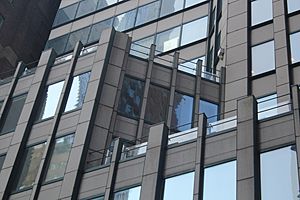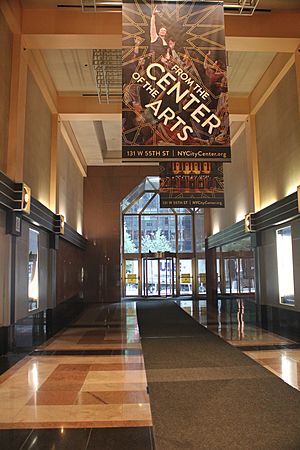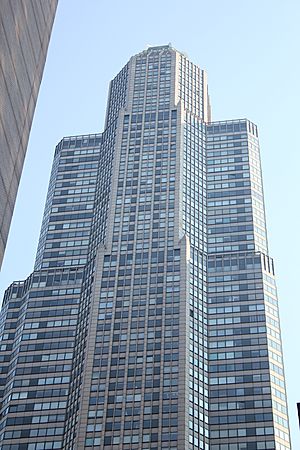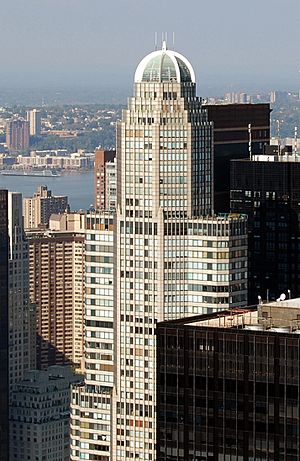CitySpire facts for kids
Quick facts for kids CitySpire |
|
|---|---|
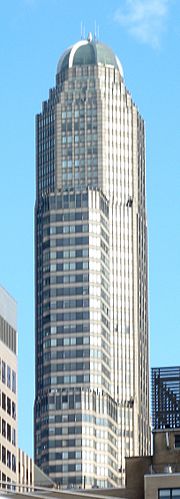
Seen in June 2005
|
|
| Alternative names | CitySpire Center |
| General information | |
| Location | 150–156 West 56th Street |
| Coordinates | 40°45′51″N 73°58′47″W / 40.76417°N 73.97972°W |
| Construction started | 1985 |
| Topped-out | June 1987 |
| Completed | 1990 |
| Owner | Tishman Speyer |
| Height | |
| Antenna spire | 814 ft (248 m) |
| Top floor | 75 |
| Technical details | |
| Floor count | 73 |
| Floor area | 830,000 sq ft (77,110 m2) |
| Lifts/elevators | 10 |
| Design and construction | |
| Architect | Murphy/Jahn |
| Developer | Ian Bruce Eichner |
| Structural engineer | Robert Rosenwasser Associates |
CitySpire (also known as CitySpire Center) is a tall skyscraper in Midtown Manhattan, New York City. It is located at 150 West 56th Street. The building was finished in 1990. It was designed by the architects Murphy/Jahn.
CitySpire stands 814 feet (248 m) (248 m) tall and has 75 stories. When it was completed, it was the second-tallest concrete building in the United States. Only the Sears Tower (now Willis Tower) in Chicago was taller. The building was developed by Ian Bruce Eichner. It was built next to the New York City Center theater.
The skyscraper has an eight-sided shape. Its dome on top was inspired by the dome of the New York City Center. The outside of the building is made of stone with glass windows. It has parts that step back at the 46th and 62nd floors. CitySpire has entrances on both 56th and 55th Streets. These entrances are connected by a walkway that is part of 6½ Avenue. The first 22 floors are used for offices and businesses. Above these floors are fancy apartments, which get bigger on the higher levels.
Ian Bruce Eichner first suggested building CitySpire in 1984. He bought special "air rights" from the City Center theater. These rights allowed him to build a much taller tower. He also agreed to make improvements to the theater. This helped him almost double the size of the tower he could build. After many city groups approved the plan, construction began in 1985. The building reached its full height by June 1987.
There was a problem when the building ended up being 11 or 14 feet (3.4 or 4.3 m) (3.4 or 4.3 m) taller than approved. Eichner agreed to add dance studios to make up for the extra height. However, these studios were never built. Soon after CitySpire opened in 1989, the building faced financial problems. For two years, a loud whistling noise came from the roof, causing many complaints.
Contents
Where is CitySpire Located?
CitySpire is at 150 West 56th Street in Midtown Manhattan. It is between Sixth Avenue and Seventh Avenue. This location is about three blocks south of Central Park. The land the building sits on is about 24,237 square feet (2,251.7 m2) (2,251.7 m2). It has a long side facing 56th Street.
The building is right next to the New York City Center theater. The City Center is a famous landmark. Other tall buildings nearby include Carnegie Hall Tower and Metropolitan Tower. This area was once a center for artists and musicians. Many buildings here were built as homes for them. Before CitySpire was built, the site had several empty lots.
How CitySpire Was Designed
CitySpire was designed by the architecture firm Murphy/Jahn. Ian Bruce Eichner developed the project. Tishman Realty & Construction built the tower. Robert Rosenwasser Associates were the engineers who made sure the building was strong. CitySpire is 814 feet (248 m) (248 m) tall. It has 75 floors above ground and two basement levels. The main concrete structure reaches 800 feet (240 m) (240 m).
Shape and Outside Look
CitySpire was planned to be an eight-sided tower. It has "wings" on its east and west sides. The building has parts that step back at the 23rd, 46th, and 62nd floors. Most of the building is not wider than 80 feet (24 m) (24 m). Because it is so narrow, the top floors can sway a little during strong storms.
The outside of the tower is made of a light-colored stone called "luna pearl." This stone is cut into thin slabs. Each stone slab is attached to an aluminum frame. This frame also forms the outer wall of the building. The stone panels are put together before they arrive at the site. They have insulation inside to keep the building warm or cool.
The roof has a copper-covered dome. This dome was originally planned to be 13 feet (4.0 m) (4.0 m) tall. When it was put in place in 1988, it had eight steel ribs. Each rib was 20 feet (6.1 m) (6.1 m) long. The dome has special openings called louvers. These louvers caused a loud whistling sound when the wind blew through them. This problem was fixed in 1992 by removing some of the panels.
Inside the Building
CitySpire has about 830,000 square feet (77,000 m2) (77,000 m2) of space. It has ten elevators that go up the building. The building's floor numbers skip 13 and 25. So, even though the top floor is numbered 75, there are actually only 73 physical stories.
The first 22 or 23 floors are used for offices. The floors above these are luxury apartments. There is also a floor for building machinery. The building was designed with great care. Even the elevator buttons were specially designed.
Ground Floor and Passageway
CitySpire includes a special walkway on its ground floor. This walkway connects 56th Street to 55th Street. It is part of a series of walkways called 6½ Avenue. These walkways help people walk through the block between Sixth and Seventh Avenues. The CitySpire walkway was opened in 1997. It was delayed because of the building's financial problems.
The walkway was designed with marble and granite walls. It has a high ceiling of 25 feet (7.6 m) (7.6 m). The style is inspired by Art Deco, with old theater posters on the walls. It has special lighting but no seats. It was made just for people to walk through.
The building has separate entrances for offices and apartments. The apartment entrance on 56th Street has a domed ceiling and wood panels. The office part of CitySpire has its own address. There is also a bar called Carnegie Club on the ground floor. The building was planned to have 305,000 square feet (28,300 m2) (28,300 m2) of office space.
Apartments in the Tower
The building was planned to have 355 luxury apartments. It was finished with 339 or 340 apartments. Most of these are homes, with a few used for other purposes. About 100 of the apartments have one bedroom. The rest have more bedrooms.
The apartments in CitySpire come in many different sizes. Many of them have terraces. Some one-bedroom apartments have living and dining rooms with unique angled walls. There are also apartments that are split over two floors, called duplexes. These have living areas on the lower floor and bedrooms on the upper floor. The apartments on higher floors are usually larger.
The very top apartment, called the penthouse, covers floors 72 through 75. It was bought in 1993 by a developer named Steven Klar. He had it redesigned. The penthouse is 8,000 square feet (740 m2) (740 m2) and has six bedrooms and nine bathrooms. It also has three terraces. The main bedroom takes up an entire floor. The penthouse has a fancy entrance, a large dining room, a wine closet, and its own private elevator.
When CitySpire was new, it offered special services to residents. These included a "SpireCard" for luxury services. It also had a media room, a lounge, and a business center. Today, the building has modern features like party rooms, conference rooms, a play area for kids, and a fitness center with a pool.
History of CitySpire
The New York City Center theater, next to CitySpire, opened in 1924. It became a theater in 1943. In the early 1980s, City Center planned to make improvements to its stage and other areas. Since City Center was a city landmark, any big changes needed approval from the city. At the same time, Ian Bruce Eichner bought the land next to the theater.
Building the Skyscraper
Planning the Tower
In May 1984, Eichner announced his plan for a 72-story skyscraper. It would have offices and apartments. The building would be eight-sided with a dome. A key part of his plan was to buy "air rights" from City Center. Air rights allow a developer to build taller if a neighboring building isn't using all its allowed height. Eichner also promised to improve City Center. This deal would give City Center money for its arts groups.
Many city groups had to approve the air rights transfer. The city's Board of Estimate approved the sale in August 1984. The Landmarks Preservation Commission also approved it in January 1985. After some changes to the design, the City Planning Commission and the Board of Estimate approved the tower itself in 1985.
The building was approved to be about 800 feet (240 m) (240 m) tall. Eichner said the tower would not cast shadows on the street. He called it a "classic New York skyscraper." Eichner received a lot of money to build it. There was an investigation in 1987 about donations Eichner made to the mayor, who had voted for the tower.
Construction Process
Construction on CitySpire began in 1985. By mid-1986, the project was known as CitySpire. There were some safety concerns during construction. People reported concrete falling from the building. Neighbors also filed lawsuits about debris and other issues.
Selling the apartments began in March 1987. Advertisements for the apartments featured famous people. However, sales were slow at first. This was partly because there were not many small apartments. Also, the area was not traditionally known for homes.
What Happened After It Opened
By early 1989, Eichner had sold many apartments and office spaces. The building was completed by 1990. However, the promised dance studios were not built on time. Eichner still had some apartments and office space left to sell.
Whistling Noise and Financial Issues
Soon after CitySpire was finished, Eichner faced financial problems. He was behind on tax payments. In October 1990, a bank started legal action over loans for the building. In December, the city fined CitySpire for noise. Hundreds of people had complained about a loud whistling sound. This noise came from the dome on the roof when wind blew through its openings.
In February 1991, a judge ordered a study on the noise. The building's owner, West 56th Street Association, filed for bankruptcy. This meant they had serious money problems. The bankruptcy stopped Eichner from having to pay some unpaid taxes. The apartment sales office also had to close.
In April 1991, the judge ruled that CitySpire was guilty of breaking noise rules. The building's managers were fined. A federal judge later said the city's noise law was unclear. The city council then worked on a new, clearer law. By May 1992, the building's managers said the whistling would be fixed. The bankruptcy plan was approved in September 1992. The roof noise was finally stopped in October. The building's owners paid the city money instead of building the dance studios.
From the Late 1990s to Today
A bank took over the residential part of the building. They renovated 75 empty apartments. These apartments were all sold by 1994. Eichner still kept his offices in CitySpire. Even though the money problems and noise were fixed, the dance studios and the public walkway were still not finished by 1995. The walkway was messy and blocked off. The owners planned to fix it and open it. They decided to create new rehearsal space inside City Center instead of building studios above the walkway.
Around 1996, new owners bought CitySpire. The building still owed money in taxes. The new owners, along with the apartment owners, paid for the walkway to be renovated. CitySpire's public walkway was finally finished in late 1997. It had taken 12 years from when it was first approved to when it opened. This walkway completed the set of public paths from 51st to 57th Street.
By 2001, a Singapore government fund owned the office floors. In 2004, Tishman Speyer bought a majority share of the office section. The Singapore fund kept a smaller share.
In 2012, Tishman Speyer and a pension fund bought CitySpire and other buildings. In the same year, the penthouse apartment was put up for sale for $100 million. This would have made it the most expensive home in New York City. However, it did not sell at that price. The owner later took it off the market. By 2015, most of CitySpire's apartments were used as second homes, not main residences. As of 2021, companies like New York Road Runners and Windels Marx have offices in CitySpire.
Images for kids
See also
 In Spanish: CitySpire Center para niños
In Spanish: CitySpire Center para niños


